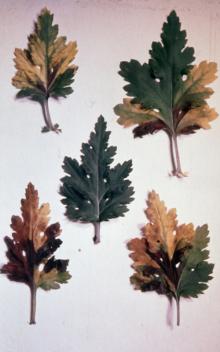Cause Aphelenchoides ritzemabosi, a foliar nematode generally found in buds and leaves of chrysanthemum although it may be detected in soil as well. Can attack related composites such as aster. Some plants can be symptomless carriers. Plants are not systemically infected. Spread can be rapid even when low-volume spray stakes are used.
Symptoms Black or brown areas in leaves. Affected areas are wedge-shaped and border the veins. Later, leaves dry, turn brown, and hang down. Generally starts with older leaves and progresses upward. Young leaves may be distorted. Feeding within the bud may kill the growing point and prevent flowering. Bud feeding also can produce malformed leaves with rough brown scars.
Sampling If a plant is suspected of having these nematodes, only the affected plant parts need to be submitted for diagnosis.
Cultural control
- Mulch to discourage nematodes from moving up from the soil.
- Keep plant tops dry by not irrigating or sprinkling overhead.
- Grow in sterile media.
- Dispose of all plant debris promptly.
- Propagate from nematode-free stock plants.
Chemical control These nematodes are also sensitive to organophosphate insecticides. Check the PNW Insect Management Handbook for current registrations and/or warnings on phytotoxicities.
- Cinnerate at 16 to 50 fl oz/100 gal water plus an adjuvant. No reentry listed. O
- Pylon miticide at 5.2 to 10 fl oz/100 gal water. Make initial application at first signs of plant damage followed by a second application in 7 to 14 days. A third application can be made in 4 to 6 weeks if plant damage is detected again. 12-hr reentry.
Reference French, N. and Barraclough, R.M. 1962. Survival of Aphelenchoides ritzemabosi (Schwartz) in soil and dry leaves. Nematologica 7:309-316.

